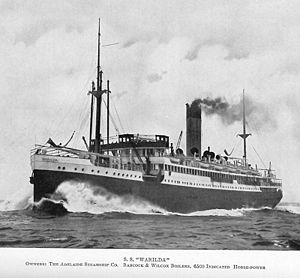Marcel Caux, born Harold Katte, was an Australian First World War veteran and the last known survivor of the Battle of Pozières.
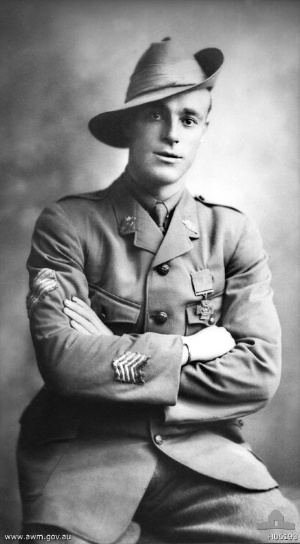
Reginald Roy Inwood, VC was an Australian soldier and recipient of the Victoria Cross, the highest award for gallantry in battle that could be awarded to a member of the Australian armed forces at the time. Inwood enlisted in the Australian Imperial Force in August 1914, and along with the rest of the 10th Battalion, he landed at Anzac Cove, Gallipoli, on 25 April 1915. He fought at Anzac until being evacuated sick to Egypt in September. He remained there until he rejoined his unit on the Western Front in June 1916. In August, he fought in the Battle of Mouquet Farm.

The Kyarra was a 6,953-ton steel cargo and passenger luxury liner, built in Scotland in 1903 for the Australian United Steam Navigation Company.
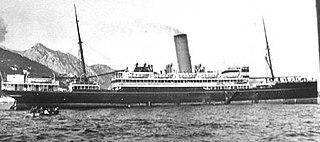
SS Zealandia, nicknamed "Z", was an Australian cargo and passenger steamship. She served as a troopship in both World War I and World War II. Zealandia transported the Australian 8th Division. Her crew were the last Allied personnel to see HMAS Sydney, which was lost with all hands in 1941. Zealandia was sunk in the air raids on Darwin of 19 February 1942.

The 10th Battalion was an infantry battalion of the Australian Army that served as part of the all-volunteer Australian Imperial Force during World War I. Among the first units raised in Australia during the war, the battalion was recruited from South Australia in August 1914 and formed part of the 3rd Brigade, 1st Division. After basic training, the battalion embarked for Egypt where further training was undertaken until the battalion was committed to the Gallipoli campaign. During the landing at Anzac Cove, it came ashore as part of the initial covering force. Members of the 10th Battalion penetrated the furthest inland of any Australian troops during the initial fighting, before the Allied advance inland was checked. After this, the battalion helped defend the beachhead against a heavy counter-attack in May, before joining the failed August Offensive. Casualties were heavy throughout the campaign and in November 1915, the surviving members were withdrawn from the peninsula. In early 1916, the battalion was reorganised in Egypt at which time it provided a cadre staff to the newly formed 50th Battalion. It was transferred to the Western Front in March 1916, and for the next two-and-a-half years took part in trench warfare in France and Belgium until the Armistice in 1918. The last detachment of men from the 10th Battalion returned to Australia in September 1919.

Claude Stanley Choules was an English-born military serviceman from Pershore, Worcestershire, who at the time of his death was the oldest combat veteran of the First World War from England, having served with the Royal Navy from 1915 until 1926. After having emigrated to Australia he served with the Royal Australian Navy, from 1926 until 1956, as a Chief Petty Officer and was a naturalised Australian citizen. He was the last surviving military witness to the scuttling of the German fleet in Scapa Flow in 1919 and the last surviving veteran to have served in both world wars. At the time of his death, he was the third-oldest verified military veteran in the world and the oldest known living man in Australia. He was the seventh-oldest living man in the world. Choules became the oldest man born in the United Kingdom following the death of Stanley Lucas on 21 June 2010. Choules died at the age of 110 years and 63 days. He had been the oldest British-born man; following his death, that honour went to Reverend Reginald Dean. In December 2011, the landing ship HMAS Choules was named after him, only the second Royal Australian Navy vessel named after a sailor.
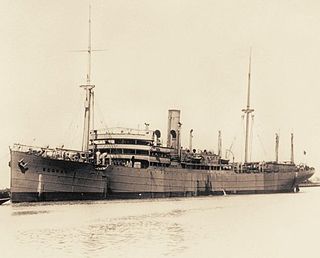
HMATBoonah was built in Germany in 1912 for the Australian trade, and known as the Melbourne. In Sydney at the outbreak of World War I in 1914, she was seized by the Commonwealth Government, renamed Boonah, and hastily converted to a troopship. In October 1918, near the end of the war, Boonah was the last Australian troop ship to leave Fremantle, Western Australia, bound for the Middle East.
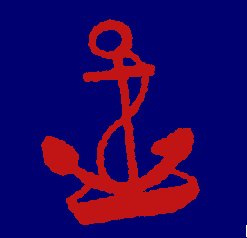
The Royal Australian Naval Bridging Train was a unique unit of the Royal Australian Navy. It was active only during the First World War, where it served in the Gallipoli and the Sinai and Palestine Campaigns. The Train was formed in February 1915 and stood down in May 1917. Throughout its existence, it was composed of Royal Australian Naval Reservists under the command of Lieutenant Commander Leighton Bracegirdle. Normally under the command of the British IX Corps, the Train also supported the I ANZAC Corps and Imperial Camel Corps in the defence of the Suez Canal.
They were the only Australian naval unit serving in a European theatre of war. They were therefore bent on proving, both to the Royal Navy and to the British Army, that they could overcome any difficulties.
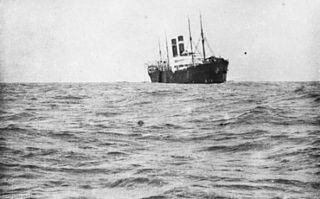
SS Vaderland was an ocean liner launched in July 1900 for the Red Star Line service between Antwerp and New York. During her passenger career, the ship initially sailed under British registry, but was re-registered in Antwerp in 1903. Vaderland was a sister ship to Zeeland and a near sister ship to Kroonland and Finland.

Fort Victoria was a 7,784 GRT passenger steamship that was built in 1912 as Willochra. During the First World War she was requisitioned for use as a troopship. In 1920 she was sold and renamed Fort Victoria, serving until lost in a collision in 1929.

MV Duntroon was a passenger motor ship built for the Melbourne Steamship Company, that saw military service as a troopship between 1942 and 1949. She was built by Swan, Hunter & Wigham Richardson, Walker, Newcastle upon Tyne, and entered service in 1939.

The Wallach brothers were a family of eight boys born to Henry and Mary Wallach of Bondi Beach in Sydney, Australia toward the end of the 19th century. Six of the brothers all saw active service in World War I. The fourth and eighth brothers, Clarrie and Neville were both top-grade rugby union players before the War. They both saw action at Gallipoli, were promoted on the Western Front as Captains, were both recipients of the Military Cross and each fell within a week of each other in France in fighting at the time of the Second Battle of Villers-Bretonneux.
Harold Alan Hamersley MC was an Australian World War I flying ace credited with 13 confirmed aerial victories. He later went on to serve in the Royal Air Force following the war, serving in India and reaching the rank of group captain before retiring.

SS Wandilla was a steamship built in 1912 for the Adelaide Steamship Company. The ship operated on the Fremantle to Sydney run until 1915, when she was acquired for military service and redesignated HMAT Wandilla. Initially used as a troop transport, the vessel was converted to a hospital ship in 1916. Wandilla was returned to her owners at the end of the war, then was sold to the Bermuda & West Indies SS Company and renamed Fort St. George in 1921. She was sold in 1935 to Lloyd Triestino and renamed Cesarea before being renamed Arno in 1938. At the start of World War II, the ship was acquired by the Regia Marina for use as a hospital ship. She was sunk by British aircraft on 10 September 1942.
Samuel Cleland Campbell was an Australian rules footballer who played with Collingwood in the Victorian Football League (VFL).

Geelong was a ship owned by the Blue Anchor Line, and, after 1910, by P&O. She was constructed in 1904 by Barclay, Curle and Co. Ltd., at Glasgow, Scotland. When originally constructed, she had accommodation for 120 saloon and 200 third-class passengers, and also carried cargo. Her gross register tonnage was 7700 tons, and she was 450 feet long, powered by triple-expansion steam engines, and capable of 14 knots, with an average cruise speed of 12 knots.

SS Georgetown Victory was a Victory ship built for the War Shipping Administration late in World War II under the Emergency Shipbuilding program. She was a type VC2-S-AP2/WSAT cargo ship with the United States Maritime Commission (MCV) -"Victory"; hull number 653, shipyard number 1597 and built by Bethlehem Shipbuilding Corporation in Baltimore, Maryland, she was laid down on 8 March 1945. Georgetown Victory, named after Georgetown University, was launched from the Bethlehem-Fairfield shipyard at Baltimore on April 28, 1945 and completed on 22 May 1945.

SS Afric was a steamship built for White Star Line by Harland and Wolff shipyards. She was of the Jubilee class, had a reported gross register tonnage of 11,948, and had a port of registry of Liverpool, England. Afric was launched on November 16, 1898, and was involved in shipping between Liverpool and Australia.
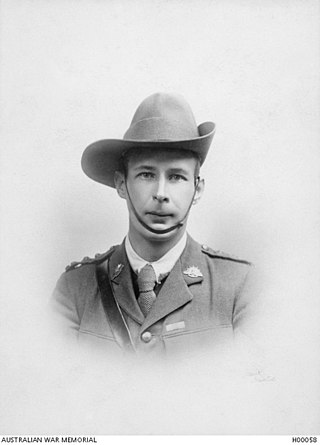
Arthur James Hillman was born in Perth, Western Australia in 1884. Arthur Hillman was a civil engineer who worked for the Public Works Department of Western Australia. He served with the Australian Army during World War I and spent most of his service tunnelling under the front line trenches in France. When he returned to Perth after the war, he resumed working for the Public Works Department. Hillman worked on water supply projects including being executive engineer on the Lower Bickley Brook Reservoir. Hillman died in 1922 as a result of an ongoing medical issue, which was caused by being gassed during WWI.

HMAT Shropshire, originally SS Shropshire, was a 11,911-ton vessel, built by John Brown and Company in Clydebank, Glasgow, for the Federal Steam Navigation Company. She was employed on passenger and meat trade between New Zealand and Great Britain, but due to the First World War, she was converted into a troopship. She was leased by the Australian Commonwealth Government until 5 August 1917, when the British Admiralty took over control of the ship.
